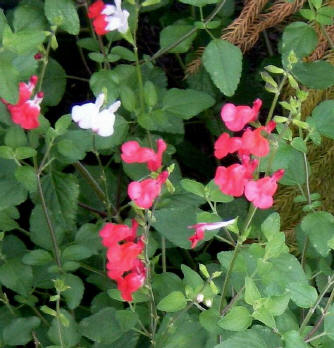Denise Dornbush
Frederick County Master Gardener Program
 Itís hard to say when my love affair with Sage began. It could have been when I smelled the crushed leaf of a Pineapple Sage. It could have been when
I read the old Chinese proverb "How can a man grow old who has Sage in his garden?" Or maybe it was when I saw the hummingbirds flock to my Sage plants.
Itís hard to say when my love affair with Sage began. It could have been when I smelled the crushed leaf of a Pineapple Sage. It could have been when
I read the old Chinese proverb "How can a man grow old who has Sage in his garden?" Or maybe it was when I saw the hummingbirds flock to my Sage plants.
Sage is a well known herb. It adorns the pages of cooking magazines, in bottles of vinegar or gracing the turkey platter. What does all this talk
about Sage have to do with Salvias? The truth is that all Sages are Salvias. Salvia is the Latin name, or genus, given to all these plants. Over the years the term Sage has
been associated with cooking or medicinal use and the term Salvia has been given to the ornamental members of the genus. So when you hear someone talking about their Salvia
officinalis Tricolor, donít be afraid; they are talking about Tricolor Garden Sage
The genus Salvia offers one of the largest and most versatile groups of perennials. The Roman scientist Pliny the Elder was the first to use the Latin
name Salvia, meaning to heal or save. The common name Sage started in England and referred to Salvia officinali, a plant used long ago as a household remedy.
Salvias are adaptable to almost any garden condition. Rabbits and deer donít bother with them and neither do most insects. They are a major source of
nectar for hummingbirds and butterflies and goldfinches love the nutritious seeds.
There are 900 recognized species of perennial, biennial and annual sages. All sages have similar flowers in any color you like from white to black and
every color in between. What is not to love about these wonderful plants?
Some of my favorites include:
- Hot Lips, a recent variety released in 2002. It has bicolor flowers of white with red lips. This attractive plant requires full sun and can reach
30 inches tall.
- Salvia coccina "Cherry Blossom" is a new addition to my garden this year. I started these, quite easily, from seed. The flowers are a very pretty
light pink, and the catalog promises that they will flower for a long period.
- Salvia nemorosa "Sensation Rose" makes a compact clump of quilted green leaves with branching flower spikes of bright pink. The flowers appear in
spring.
- Peruvian Andean Silver Salvia is a tender perennial. This is a beautiful plant with purple-black flowers and lime green calyces (the little cups
that holds the flowers.) The leaves are silvery and the stems are cloaked in woolly, white hairs. This plant grows to about 18 inches tall.
- Black and Blue Salvia or Blue anise sage is a tall plant that will reach 2 to 3 feet in height. The bi-colored blooms appear in both the spring and
the fall. The calyx is unusual in that itís black instead of the usual green and the deep blue blooms are a favorite of hummingbirds.
Another plant I started from seed this year is Salvia argentea "Artemis." In the first year this plant makes small rosettes of soft grey woolly
foliage. This plant just begs to be touched. Next year the plant will have tall silver spikes with pinkish-white flowers. What an added bonus! Iím happy with it now; it
doesnít need to do anything else next year.
The list of wonderful sages to grow in the garden continues with:
- Salvia lyrata "Purple Knockout" (Lyre-leaf sage) is grown mainly for its leaves. Burgundy leaves turn deep purple in the summer. Spikes of pale
lilac flowers appear in spring and summer. This plant self sows.
- Russian Sage is graceful and airy, growing 3 to 5 feet tall, topped with lavender flowers. These are very easy to grow. They tolerate poor soil and
drought.
- Tricolor Sage has green leaves with white margins with pink or purple. This woody stemmed plant can be trimmed back in the spring. In early summer
it sends up lavender-purple spikes. These last a long time in cut arrangements.
- Pineapple Sage is a fun plant to have in the garden. Not only do the leaves smell like fresh pineapple, the plant provides color in the late summer
and fall garden. Pineapple sage will wilt and lose leaves during droughts. It is grown as an annual in this area and overwinters well indoors.
- Victoria Sage is a small plant that is big on color. This was one of my first sages and I was happy to find out that it overwinters in this area.
Spikes of stunning violet-blue flowers in the summer make this well worth growing. The upright plant is moderately fast-growing and has green lance-shaped leaves which are
covered with fine hairs. This is wonderful in cut arrangements and lasts a long time.
Few groups of plants add as much to a garden as salvias. They are as different in fragrance as they are in bloom, habit and color. I hope you will
take this sage advice and consider adding some salvias to your gardens. The hummingbirds and butterflies will thank you by gracing your gardens.
Read other articles on plants and flowers
Read other summer related gardening articles
Read other article by Denise Dornbush